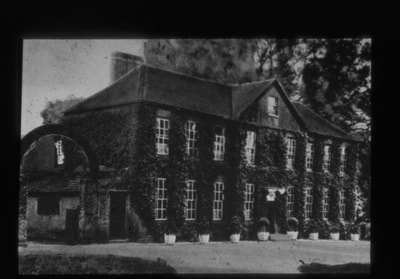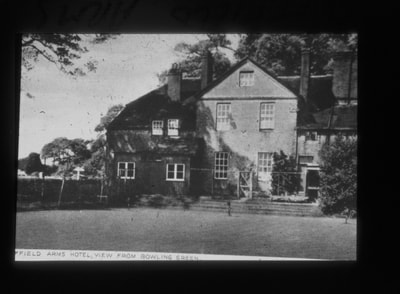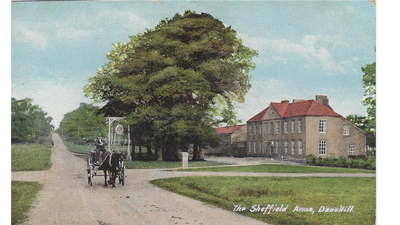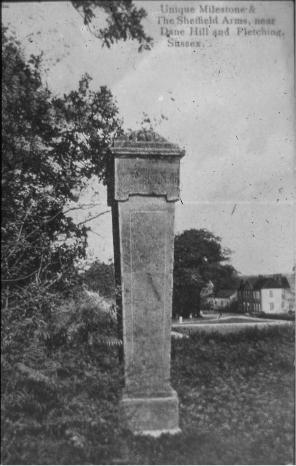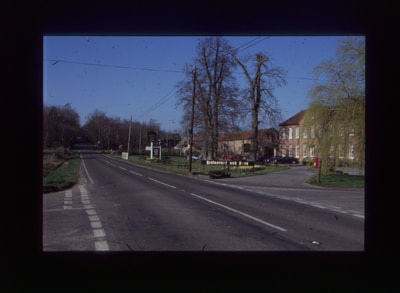Sheffield Arms (now Trading Boundaries)
Unusually the Sheffield Arms was built as a Coaching Inn. The London-Lewes road was turnpiked in 1752 between Offham and Wych Cross. This greatly improved the condition of the road and just 4 years later James Batchelar, who owned the Dorset Arms at East Grinstead, began a regular stagecoach route from London to the new fashionable health resort of Brighthelmstone (Brighton). At a speed of around 4mph the journey could just be done in one day. The venture seems to have been successful as before long there were competitors for the trade. The journey cost 16 shillings which today would be £150. The travellers must have been keen for the new-fangled sea bathing experience. The stagecoaches often got literally stuck in the mud or worse toppled over. Passenger space was extremely cramped with upright seats and passengers would have had to walk up steep hills. For £75 you could ride on the roof or in the rumble-tumble. This was a straw basket meant for luggage, but with the addition of some straw made for a very uncomfortable experience. People who elected for the rumble-tumble were described as 'basket cases'. The early coaches were more like wagons with no brakes or suspension and extremely heavy. Six horses were needed with a postillion (a look-out on the front horse because the driver could not see the road ahead). Braking was by means of a skidpan which resembled a shovel and was forced under a rear wheel so the wheel stopped turning and the coach slid down on the pan. Administering the skidpan was a skilled job. If it failed the horses would be pushed down the hill and would be forced into a dangerous gallop.
The horses would tire so it was necessary to rest them at regular intervals, which is where coaching inns come into the picture. Passengers could get some food and stretch and warm themselves while the horses recuperated. In time coaches were much improved with brakes and suspension and lighter weight. They could be pulled by fewer horses and by changing the team of horses at 'stages', around 10 miles apart along the route, speeds of 7-8mph could be maintained. The coaching inns became even more important as they could provide the fresh horses and stable the tired ones.
After East Grinstead, Dorset Arms there were no inns before Lewes, a long distance of 20 miles. In 1777 Lord Sheffield decided to build a new inn at Sheffield Crossroads just south of Furners Green. He built a sophisticated building which also doubled up as a place for his visitors to stay and to hold public meetings such as magistrates courts. The building was fitted out by the first tenant, John Fletcher, who moved in in 1779, but by 1781 he was bankrupt. The next tenant lasted just one year. The inn struggled to make a profit throughout its lifetime, especially once a new shorter London to Brighton route was established through Cuckfield. However the grand building has survived as an oddball shopping complex, Trading Boundaries.
Unusually the Sheffield Arms was built as a Coaching Inn. The London-Lewes road was turnpiked in 1752 between Offham and Wych Cross. This greatly improved the condition of the road and just 4 years later James Batchelar, who owned the Dorset Arms at East Grinstead, began a regular stagecoach route from London to the new fashionable health resort of Brighthelmstone (Brighton). At a speed of around 4mph the journey could just be done in one day. The venture seems to have been successful as before long there were competitors for the trade. The journey cost 16 shillings which today would be £150. The travellers must have been keen for the new-fangled sea bathing experience. The stagecoaches often got literally stuck in the mud or worse toppled over. Passenger space was extremely cramped with upright seats and passengers would have had to walk up steep hills. For £75 you could ride on the roof or in the rumble-tumble. This was a straw basket meant for luggage, but with the addition of some straw made for a very uncomfortable experience. People who elected for the rumble-tumble were described as 'basket cases'. The early coaches were more like wagons with no brakes or suspension and extremely heavy. Six horses were needed with a postillion (a look-out on the front horse because the driver could not see the road ahead). Braking was by means of a skidpan which resembled a shovel and was forced under a rear wheel so the wheel stopped turning and the coach slid down on the pan. Administering the skidpan was a skilled job. If it failed the horses would be pushed down the hill and would be forced into a dangerous gallop.
The horses would tire so it was necessary to rest them at regular intervals, which is where coaching inns come into the picture. Passengers could get some food and stretch and warm themselves while the horses recuperated. In time coaches were much improved with brakes and suspension and lighter weight. They could be pulled by fewer horses and by changing the team of horses at 'stages', around 10 miles apart along the route, speeds of 7-8mph could be maintained. The coaching inns became even more important as they could provide the fresh horses and stable the tired ones.
After East Grinstead, Dorset Arms there were no inns before Lewes, a long distance of 20 miles. In 1777 Lord Sheffield decided to build a new inn at Sheffield Crossroads just south of Furners Green. He built a sophisticated building which also doubled up as a place for his visitors to stay and to hold public meetings such as magistrates courts. The building was fitted out by the first tenant, John Fletcher, who moved in in 1779, but by 1781 he was bankrupt. The next tenant lasted just one year. The inn struggled to make a profit throughout its lifetime, especially once a new shorter London to Brighton route was established through Cuckfield. However the grand building has survived as an oddball shopping complex, Trading Boundaries.

